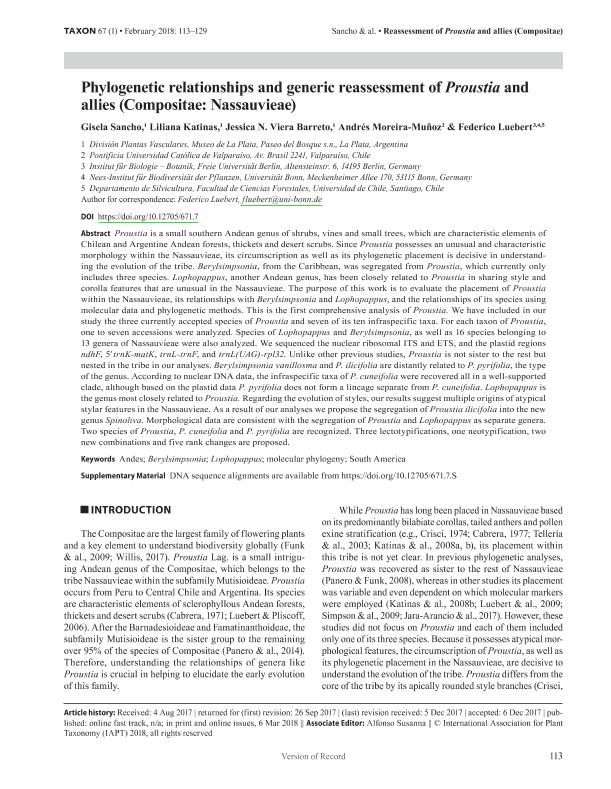Mostrar el registro sencillo del ítem
dc.contributor.author
Sancho, Gisela

dc.contributor.author
Katinas, Liliana

dc.contributor.author
Viera Barreto, Jessica Noelia

dc.contributor.author
Moreira Muñoz, Andrés Sergio

dc.contributor.author
Luebert, Federico
dc.date.available
2020-03-30T17:23:17Z
dc.date.issued
2018-03
dc.identifier.citation
Sancho, Gisela; Katinas, Liliana; Viera Barreto, Jessica Noelia; Moreira Muñoz, Andrés Sergio; Luebert, Federico; Phylogenetic relationships and generic reassessment of proustia and allies (Compositae: Nassauvieae); International Association for Plant Taxonomy; Taxon; 67; 1; 3-2018; 113-129
dc.identifier.issn
0040-0262
dc.identifier.uri
http://hdl.handle.net/11336/101368
dc.description.abstract
Proustia is a small southern Andean genus of shrubs, vines and small trees, which are characteristic elements of Chilean and Argentine Andean forests, thickets and desert scrubs. Since Proustia possesses an unusual and characteristic morphology within the Nassauvieae, its circumscription as well as its phylogenetic placement is decisive in understanding the evolution of the tribe. Berylsimpsonia, from the Caribbean, was segregated from Proustia, which currently only includes three species. Lophopappus, another Andean genus, has been closely related to Proustia in sharing style and corolla features that are unusual in the Nassauvieae. The purpose of this work is to evaluate the placement of Proustia within the Nassauvieae, its relationships with Berylsimpsonia and Lophopappus, and the relationships of its species using molecular data and phylogenetic methods. This is the first comprehensive analysis of Proustia. We have included in our study the three currently accepted species of Proustia and seven of its ten infraspecific taxa. For each taxon of Proustia, one to seven accessions were analyzed. Species of Lophopappus and Berylsimpsonia, as well as 16 species belonging to 13 genera of Nassauvieae were also analyzed. We sequenced the nuclear ribosomal ITS and ETS, and the plastid regions ndhF, 5′ trnK-matK, trnL-trnF, and trnL(UAG)-rpl32. Unlike other previous studies, Proustia is not sister to the rest but nested in the tribe in our analyses. Berylsimpsonia vanillosma and P. ilicifolia are distantly related to P. pyrifolia, the type of the genus. According to nuclear DNA data, the infraspecific taxa of P. cuneifolia were recovered all in a well-supported clade, although based on the plastid data P. pyrifolia does not form a lineage separate from P. cuneifolia. Lophopappus is the genus most closely related to Proustia. Regarding the evolution of styles, our results suggest multiple origins of atypical stylar features in the Nassauvieae. As a result of our analyses we propose the segregation of Proustia ilicifolia into the new genus Spinoliva. Morphological data are consistent with the segregation of Proustia and Lophopappus as separate genera. Two species of Proustia, P. cuneifolia and P. pyrifolia are recognized. Three lectotypifications, one neotypification, two new combinations and five rank changes are proposed.
dc.format
application/pdf
dc.language.iso
eng
dc.publisher
International Association for Plant Taxonomy

dc.rights
info:eu-repo/semantics/openAccess
dc.rights.uri
https://creativecommons.org/licenses/by-nc-sa/2.5/ar/
dc.subject
ANDES
dc.subject
BERYLSIMPSONIA
dc.subject
LOPHOPAPPUS
dc.subject
MOLECULAR PHYLOGENY
dc.subject
SOUTH AMERICA
dc.subject.classification
Ciencias de las Plantas, Botánica

dc.subject.classification
Ciencias Biológicas

dc.subject.classification
CIENCIAS NATURALES Y EXACTAS

dc.title
Phylogenetic relationships and generic reassessment of proustia and allies (Compositae: Nassauvieae)
dc.type
info:eu-repo/semantics/article
dc.type
info:ar-repo/semantics/artículo
dc.type
info:eu-repo/semantics/publishedVersion
dc.date.updated
2020-03-12T18:45:20Z
dc.journal.volume
67
dc.journal.number
1
dc.journal.pagination
113-129
dc.journal.pais
Austria

dc.journal.ciudad
Viena
dc.description.fil
Fil: Sancho, Gisela. Universidad Nacional de La Plata. Facultad de Ciencias Naturales y Museo. División de Plantas Vasculares; Argentina. Consejo Nacional de Investigaciones Científicas y Técnicas. Centro Científico Tecnológico Conicet - La Plata; Argentina
dc.description.fil
Fil: Katinas, Liliana. Universidad Nacional de La Plata. Facultad de Ciencias Naturales y Museo. División de Plantas Vasculares; Argentina. Consejo Nacional de Investigaciones Científicas y Técnicas. Centro Científico Tecnológico Conicet - La Plata; Argentina
dc.description.fil
Fil: Viera Barreto, Jessica Noelia. Universidad Nacional de La Plata. Facultad de Ciencias Naturales y Museo. División de Plantas Vasculares; Argentina. Consejo Nacional de Investigaciones Científicas y Técnicas. Centro Científico Tecnológico Conicet - La Plata; Argentina
dc.description.fil
Fil: Moreira Muñoz, Andrés Sergio. Pontificia Universidad Católica de Valparaíso; Chile
dc.description.fil
Fil: Luebert, Federico. Freie Universität Berlin. Institut für Biologie-Botanik ; Alemania. Universitat Bonn; Alemania. Universidad de Chile; Chile
dc.journal.title
Taxon

dc.relation.alternativeid
info:eu-repo/semantics/altIdentifier/doi/http://dx.doi.org/10.12705/671.7
dc.relation.alternativeid
info:eu-repo/semantics/altIdentifier/url/https://onlinelibrary.wiley.com/doi/abs/10.12705/671.7
dc.relation.alternativeid
info:eu-repo/semantics/altIdentifier/url/https://www.semanticscholar.org/paper/Phylogenetic-relationships-and-generic-reassessment-Sancho-Katinas/2062a43d7a465d53bfa1f1b3506f363c81e61312
Archivos asociados
